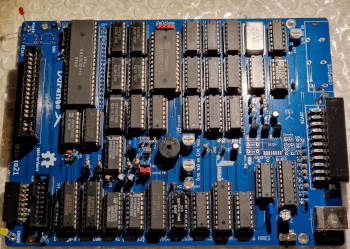Durango

Originally born as a 6502 tester without any specific chips, soon became a full-featured home computer with integrated video output.
For advanced information, check the Theory of Operation. If you already own a Durango-X computer and it's acting up, you may be interested in the Troubleshooting Guide as well.
Range
- Durango PROTO: the original CPU tester with some basic I/O (1 MHz)
- Durango·SV: 16-colour video output module for SVGA monitor (abandoned)
- Durango·S: 128x128 pixel, 16-colour home computer
- Durango·R: as above but displaying 256x256 monochrome instead
- Durango·X: full model, with both the ·S and ·R models video output (software switchable)
- Durango·C: simplifed, reduced chip-count version of Durango-X (under development)
- Durango Pocket: handheld 2 MHz version, although not ~~fully~~ compatible (under development)
Basic Specs
- CPU: 65C02 @ 1.536 MHz
- ROM: up to 32 KiB cartridge slot (more with bank switching)
- RAM: 32 KiB
- Expansion connector: parallel 8-bit bus with 16 addresses for keyboards, joysticks etc.
- Video output: via CCIR (PAL) TV thru RGB SCART connector.
Also available as options: composite video (greyscale/HIRES only), Sync-on-Green and Component Video outputs.
Note
Revision v2 will increase the clock speed up to 1.75 MHz, plus an option for a TURBO mode at twice the speed -- a whopping 3.5 MHz !!
Video Modes
- 128 x 128 px. 4 bpp (256-raster, 16-colour GRgB fixed palette, no restrictions) except in ·R model
- 256 x 256 px. 1 bpp (monochrome) except in ·S model
- Switchable greyscale mode (16 levels) except in ·R model and Sync-on-Green/Component video options
- Inverse Video mode (hardware)
- Four 8 KiB screens software-switchable (screen 0 is shared with ZP, stack etc)
Note
Built-in screen for Pocket model to be determined.
Warning
The Durango-X computer is designed to be hooked to a TV or monitor conforming to the CCIR (PAL) 50 Hz standard. While a mod (under development) may generate a proper EIA (NTSC) 60 Hz signal, there is no way to fit the usual 256-raster image on such displays -- 240 rasters being the absolute limit, and very few sets will actually display more than 215-220 rasters. All software will run, but the bottom of the screen may become invisible. Revision 2 will be available with a 60 Hz option (different board) displaying 192 rasters at once, with a pushbutton to momentarily show the bottom rasters.
Note
The EIA (60 Hz) version of the revision v2 is expected to run at ~1.5734 MHz (with a TURBO option of ~3.15 MHz)
Options
The Durango project allows to build your computer under several configuration options, all of them using the same PCB, by just choosing the appropriate components.
Warning
Generally speaking, as the Durango computer provides a slightly non-standard video signal, some displays might be incompatible, no matter the chosen option (although this is quite rare according to our experience so far).
Supported video mode options
- Durango-S: colour mode only (128 x 128 px., 4 bpp)
- Durango-R: HIRES mode only (256 x 256 px., 1 bpp)
- Durango-X: both modes available (recommended option)
Video output options
- RGB-SCART (recommended option): will display colour on RGB mode only, as composite output needs the PAL encoder.
- Sync-on-green: suitable for some monitors, especially the Sony PVM range, via RCA connectors. Note that greyscale mode is not available.
Note
Future revisions (v2 onwards) of the Durango-X board will replace the Sync-on-green option by a Component video output, which is both suitable for the PVM monitors and more modern TV sets, lacking SCART socket.
PAL encoder option
- with PAL encoder (AD724): composite output (from SCART and/or RCA) may be in colour.
- No PAL encoder (recommended option): composite output is greyscale.
Bug
The PAL encoder option was an afterthought, thus picture quality may be poor or, on some devices, may not display any colour at all. This has been deprecated on revision 2 of the board.
Second composite output option
This adds an RCA jack (together with a couple more for audio) with composite video output, although it will be grayscale unless the PAL encoder option is installed. If both this output and the one on the SCART are to be used at the same time, you may wish to swap R15 for a lower value (say, 180 ohm) for picture stability.
Tip
The Sync-on-green option, unlike the SCART, does NOT provide audio output, thus the extra 3 RCA jack set intended for the Second video output may be desired for audio, even if the second video output isn't functional.